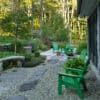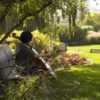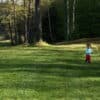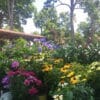Learning Landscape Design From Thoreau
 (photo: Nicola Browne)
(photo: Nicola Browne)
When I used to take a daily walk with my dogs, I would pass by two little huts that I longed to inhabit: a little stone pump house by a brook, and a dilapidated brown cottage that sat rotting away in a grove of old hemlock trees. The latter especially ignited my imagination. I longed to storm its ancient doors, break in, and establish a secret hideaway for myself in the trees, with no phones, no internet, no stress of any sort to divert myself from myself. There, I’d be carefree: I’d read favorite novels, write a few lines, snatch a nap or two, and daydream the day away, sneaking back to my bigger house in time to make dinner, help with homework, and begin my “real” life again with the pleasure that having enjoyed a room of my own could only give.

photo: Randy O’Rourke — Location: Ohio
I imagine that this was the same longing that Henry David Thoreau experienced when he lived by himself in the woods on Walden Pond in Concord, Massachusetts, not twenty minutes away from where I used to live. Despite my close proximity to Concord, I had never been to Thoreau’s Walden. I had driven past and looked down upon the smooth waters of its pond, but had never traipsed the quarter way around it to view his house site. So finally, I indulged my curiosity on a perfect spring day, leaving the car in the parking lot and finding myself standing in front of a small, wood frame hut with a bronze sculpture of Thoreau in front of it. A reproduction of his famous house, it was tiny: measuring only ten by fifteen feet with a window at each long side, a door at the south end, and a fireplace and chimney at the north end. Peering inside, I saw a low cot under the east window, a small round green-painted table and three chairs. In front of the house is a sign saying:
I went to the woods because I wished to live deliberately, to front only the essential facts of life. And see if I could not learn what it had to teach and not, when I came to die, discover that I had not lived.”The purity of the concept: to live so simply, to build one’s own hut in the wilderness, to grow one’s own vegetables, catch fish, and if necessary, trap game – in short, to find one’s self in a remote landscape–is a romantic ideal for us all. The difference between Thoreau and us is that he lived out the dream, for just over two years, in Walden.
In late March of 1845, Thoreau at twenty-seven decided to become a writer. His previous employment after graduation from Harvard had been as a teacher, pencil maker, and handyman. One day, Thoreau received a letter from his friend Channing, who had lived alone in a hut on the Illinois prairie, urging him to go out to the Walden woods in order to “build yourself a hut, and there begin the grand process of devouring yourself alive.” Ralph Waldo Emerson’s book Nature had influenced him: “To go into solitude, a man needs to retire as much from his chamber as from society. I am not solitary whilst I read and write, though nobody is with me. But if a man would be alone, let him look at the stars.”
Thoreau started work on a cabin in the woods just above Walden Pond, a large glacial kettlehole surrounded by softly rolling, wooded terrain, just two miles southeast of the village of Concord. Emerson, his friend, owned the land. With an ax he borrowed from another friend, Bronson Alcott, he set about cutting white pines to frame his new, but tiny, abode.
“It was a pleasant hillside where I worked, covered with pine woods, through which I looked out on the pond, and a small open field in the woods where pines and hickories were springing up… They were pleasant spring days, in which the winter of man’s discontent was thawing as well as the earth, and the life that had lain torpid began to stretch itself… So I went on for some days cutting and hewing timber, and also studs and rafters, all with my narrow ax.” He built the house alone, except for help raising the frame, when he brought in friends and neighbors including Emerson, Alcott, his friend Ellery Channing, and his favorite Concord farmer, Edmund Hosmer, and his sons. “No man was ever more honored in the character of his raisers than I,” he wrote. After clearing two and a half acres of briar to create a vegetable garden for potatoes, peas, corn, beans, and turnips, and cladding and finishing his cabin, complete with woodshed and outhouse as separate little buildings, he was finished. He wrote that his furnishings consisted of “a bed, a table, a desk, three chairs, a looking-glass three inches in diameter, a pair of tongs and andirons, a kettle, a skillet, and a frying-pan, a dipper, a wash-bowl, two knives and forks, three plates, one cup, one spoon, a jug for molasses, and a japanned lamp.” His precise calculations of the cost of the whole endeavor came to $28.12, less by nearly two dollars than the cost of his dorm room at Harvard for a year.
His friend Channing described his house in rapturous tones: “It was just large enough for one… It was so superior to the common domestic contrivance that I do not associate it with them… It had no lock to the door, no curtain to the window, and belonged to nature as much as to man.” When you go to his building site today, all that is left are an outline of bollards and the sign mentioned above.
Thoreau not only built a hut in the Walden Woods, he also explored it thoroughly on a daily basis. He saw his world as a garden: “For my afternoon walks I have a garden, larger than any artificial garden that I have read of and far more attractive to me – mile after mile of embowered walks, such as no nobleman’s grounds can boast, with animals running free and wild therein as from the first – varied with land and water prospect, and, above all, so retired that it is extremely rare that I meet a single wanderer in its mazes. No gardener is seen therein. You may wander away to solitary bowers and brooks and hills.”
Thoreau’s profession was “to be always on the alert to find God in nature, to know his lurking places, to attend all the oratorios, the opera, in nature.” Yet on September 6, 1847, two years, two months and two days after he moved in, he left Walden. “I left the woods for as good a reason as I went there. Perhaps it seemed to me that I had several more lives to live, and could not spare any more time for that one. It is remarkable how easily and insensibly we fall into a particular route, and make a beaten track for ourselves. I had not lived there a week before my feet wore a path from my door to the pondside; and though it is five or six years since I trod it, it is still quite distinct.”

photo: Myke Hodgins — Location: Canada
He later wrote about his experience in Walden: “I learned this, at least, by my experiment: that if one advances confidently in the direction of his dreams, and endeavors to live the life which he has imagined, he will meet with a success unexpected in common hours. He will put some things behind, will pass an invisible boundary; new, universal, and more liberal laws will begin to establish themselves around and within him; or the old laws be expanded, and interpreted in a more liberal sense, and he will live with the license of a higher order of beings. In proportion as he simplifies his life, solitude will not be solitude, nor poverty poverty, nor weakness weakness.” Would that we all could be so deliberate, so modest, and so articulate. I wish each one of you a hut of your own. – JMM






The article has inspired me to make my hut this summer.
I remember how much peace and quietness of mind i received when i first read Thoreau. I think that is what i still try to capture as i work and enjoy my little piece of earth the good Lord has given me to enjoy.
Nature is such an amazing place, I try to hang out there every chance I get. Thanks for the beautiful pictures and thoughts!
Posts like this brighten up my day. Thanks for taking the time.